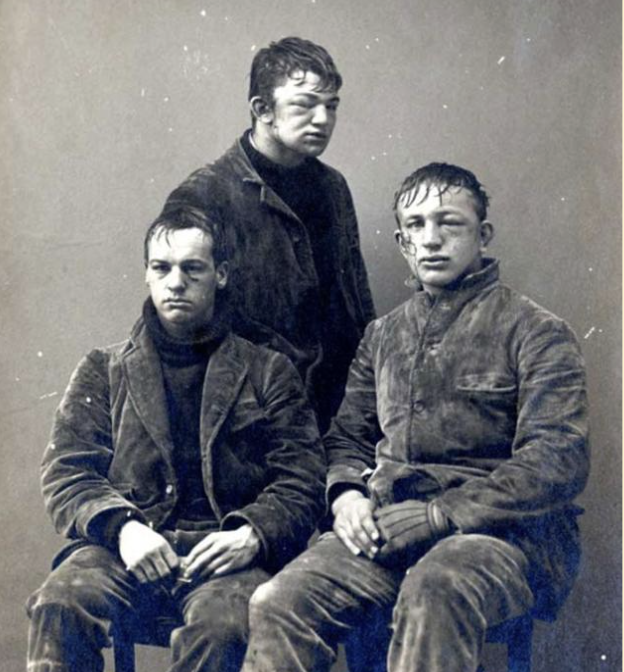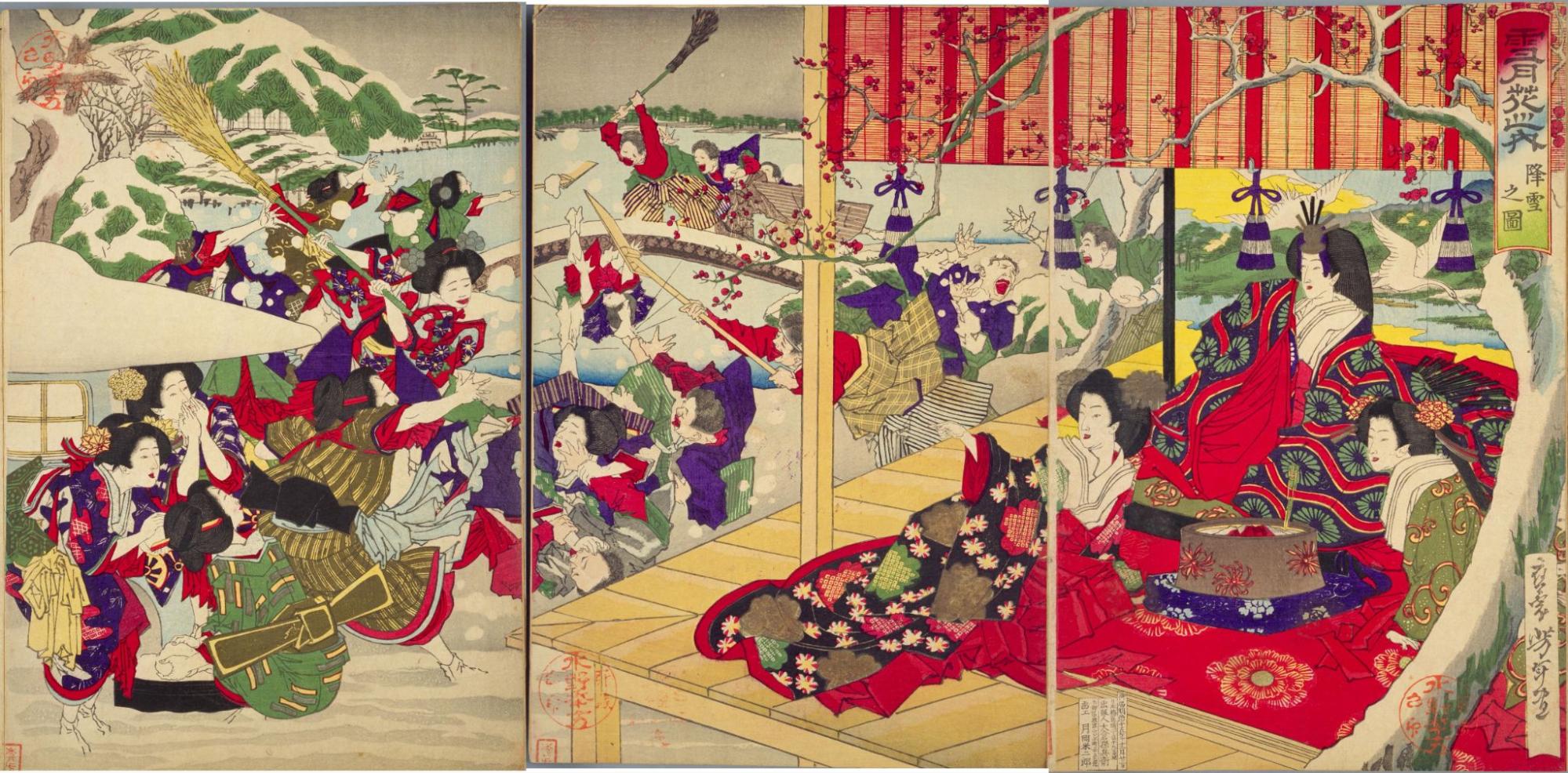1.2 Chapter Story
SNOWBALL FIGHTS IN FRANCE AND BAGHDAD: THE STUDY OF OUR LIVES
In 2020, a video emerged on social media depicting a curious scene from 1897 in Lyons, France (figure 1.1). Joyous adults are engaged in a snowball fight in the street. Women join in their work aprons. One man in coattails seems especially enthralled with the game. A bicyclist attempts to pedal through the scene but is pelted as well, causing him to fall heels-up in the snow.
https://www.youtube.com/watch?v=nwxtBsBGdPk
The original version was shot by Auguste and Louis Lumière. The Lumière brothers are considered the fathers of cinematography, having filmed the first motion picture two years previously, marking a major achievement in communications technology. “Snowball Fight” went viral in 2020 after amateur Russian photographer Joaquim Campa applied artificial intelligence (AI) software to colorize it and smooth out the motion (Anderson 2020). Take a look at the 52-second film. As you do, can you imagine why the scene was so enthralling that it went viral?
Below the video, one commenter exclaimed: “It’s surreal to watch people from more than a hundred years ago having fun in much the same way we would today.” New York Times writer Sam Anderson (2020) wrote about his fascination this way:
On an intellectual level, we all understand that historical people were basically just like us.…The ancestors who laid down our roads and built our houses and planted the trees whose leaves still clog our gutters.…
They lived, as we do, in the throbbing nerve pocket of the now. They were anxious and unsure, bored and silly. Nothing that would happen in their lifetimes had happened yet. The ocean of time was crashing fresh waves, nonstop, against the rocks of their days. And like us they stood there, gasping in the cold spray, wondering what people of the past were like.
Our Fascinating Lives
You’ve likely wondered what life was like 100 years ago or so. Was it harder? Was it more enjoyable in some ways? How did people love? What was it like to raise children? “Snowball Fight” may be fascinating to us because it allows us a peek into these mysteries. We wonder about these individuals, called away from their day to play in the snow.
“Snowball Fight” may also be intriguing because, as observers from a different era, we sense that those individuals’ lives were shaped by societal realities of the time. Various social, cultural, and political circumstances—of the past and present—shaped the life experiences of each snowball fighter that winter in 1897. Equally important were the environmental circumstances that impacted their lives and how all of those variables interacted.
These kinds of images also inspire us to compare the experiences of groups living at the same time. Consider figure 1.2, which is a photograph taken at Princeton University in 1893, snapped just after a snowball fight between freshmen and sophomores. It seems this group had a much different encounter than those in the Lumière film four years later. What social dynamics can you imagine were at play with the Princeton University students before this photograph was taken? Did snowball fights have a different meaning to them than to residents of Lyons?

Images can also inspire us to make comparisons between societies across time. Take a look at some images of snowball fights around the world (figures 1.3, 1.4, and 1.5). What social circumstances can you imagine existed during those scenes? What different meanings can you imagine were associated with the snowball fight across the centuries and locations represented?



For example, the circa-1400 picture of a snowball fight in figure 1.5 is found in a Latin edition of Tacuinum Sanitatis. Philosopher Ibn Butlan of Baghdad wrote the Arab medical handbook in the 11th century. It contains illustrations and writing on physical and mental well-being, including topics such as the benefits of fresh air and alternating activity and rest. The handbook was popular into the 16th century and demonstrates the strong influence of Arab culture on people living in early modern Europe (Loudon 2002). The edition was printed in Lombardy, Italy, so we might assume that 13th-century residents of Lombardy found the snowball fight integral to good health.
This collection of images also confirms that snowball fights have been common across societies for some time. Said another way, snowball fights are part of culturally universal expressions. Culture is the shared beliefs, values, and practices in a group or society. In the social sciences, a cultural universal refers to concepts, ideas, or patterns of behavior that are common to all human cultures. Snow is not available in all parts of the world, but play-fighting and humor do exist universally. While social circumstances change over time, impacting peoples’ lives differently, much also stays the same across centuries and continents.
Social Change, Your Community, and You
When we are inspired to imagine how social realities shape people’s lives, we are beginning to practice the art of sociology. As we wonder about the meaning that members of society place on activities like snowball fights, then make comparisons to find differences or universal experiences, we are also practicing sociology. Similarly, when we look at societal changes over time that influence those experiences, we practice the study of social change.
This textbook will focus on how sociology views and studies social change. We’ll define sociology and social change in the next pages. We’ll then explore how sociologists apply data and diverse perspectives to understand the interactions between individuals and the society around them. We’ll explore the causes, impacts, and dynamics of social change, focusing on how societies are organized, current and historical events, and unequal power relations. We’ll also explore ways of better understanding how to contribute to social change in a variety of settings: within civil society, government, or private agencies; as volunteer activists; or working in your chosen professions.
Before we dive far into the discipline of sociology, we want to encourage you to look further into how social change matters to you and your community in your everyday lives. By community, we mean a group of people with whom you share relationships, experiences, and a sense of meaning and belonging. In this chapter, we’ll focus on the meaning of sociology and the importance of acknowledging diverse experiences as we practice sociology.
We’ll look broadly at the era during which “Snowball Fight” was filmed to show how we can make more connections. Then, to support your exploration of how social change matters to you, we’ll introduce some societies that we hope have different cultural expressions than what you are familiar with. We’ll highlight perspectives from three societies less entrenched in colonized and European influences: Sámi people living near the Arctic Circle, war resisters of northern Colombia, and Quechua and Aymara communities of the Andes in South America. This chapter will encourage you to ask questions about how experiences of social change differ based on diverse environmental circumstances, historical realities, and cultural perspectives.
- How do environmental changes affect communities’ experience with social change?
- How does war affect communities’ experience with social change?
- How does culture affect communities’ experience with social change?
It’s a powerful exercise to frame social change in the context of your own experience and that of your community. This chapter also prompts you to explore:
- What does social change mean to you and your community according to the history, cultural perspectives, and environmental circumstances you have experienced?
Going Deeper
See more photos of snowball fighting in this collection of “Snowball Fights in Art” [Website] from 1400 to 1946.
Licenses and Attributions for Chapter Story
Open Content, Original
“Chapter Story” by Aimee Samara Krouskop is licensed under CC BY-SA 4.0.
Open Content, Shared Previously
Figure 1.2. “Princeton students after a snowball fight between freshman and sophomores, 1893,” (cropped) is on Wikimedia Commons and in the public domain.
Figure 1.3. “NDL-DC 1312538-Tsukioka Yoshitoshi” by Yoshitoshi, on Wikimedia Commons is in the public domain. Courtesy of National Diet Library Digital Collections.
Figure 1.4. “TF Gold Geronimo soldiers, Paktya PRT wage epic snow fight at Gardez” by Spc. Ken Scar, on Wikimedia Commons, is in the public domain.
Figure 1.5. “Albucasis-Observations sur divers actes de la vie humaine” (cropped) is in the public domain. Courtesy of Bibliothèque nationale de France. Département des Manuscrits.
All Rights Reserved Content
Figure 1.1. “Snowball fight (Lyon, France in 1896)” [Streaming Video] by 백주부손맛 is included under fair use.
the shared beliefs, values, and practices in a group or society. It includes symbols, language, and artifacts.
the extent of a person’s physical, mental, and social well-being.
concepts, ideas, or patterns of behavior that are common to all human cultures.
a science guided by the understanding that the social matters: our lives are affected, not only by our individual characteristics but by our place in the social world, not only by natural forces but by their social dimension.
the way human interactions and relationships transform cultural and social institutions over time.
the communities, groups, and organizations that function outside of government to provide support and advocacy for certain people or issues in society.
the institution by which a society organizes itself and allocates authority to accomplish collective goals and provide benefits that a society needs.
a group of people that share relationships, experiences, and a sense of meaning and belonging.

